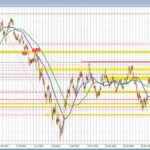
Navigating the Waves: Understanding Recent EUR/USD Fluctuations
Tháng 4 11, 2025Navigating Turbulent Waters: Key Themes Shaping the Global Financial Market
Tháng 4 11, 2025U.S.-China Trade Tensions Drive Market Volatility and Surge in Safe-Haven Assets
Recent developments in the financial markets have been significantly shaped by the escalating trade tensions between the United States and China, culminating in a dramatic increase in tariffs that have now reached a staggering 145%. This surge in tariffs has not only heightened volatility across global markets but has also impacted equities and currencies, leading to a notable increase in demand for safe-haven assets such as gold and silver. For a more in-depth look at China’s strategic response to these trade tensions, you can read about it here.
U.S. Dollar Faces Significant Pressure
The U.S. dollar has been subjected to severe pressures, marking its most considerable decline since November 2022. This downturn, with a notable drop of approximately 1.83% in a single day, was fueled by lower-than-expected inflation data. The ramifications of this decrease have been profound, particularly against major currencies like the Swiss franc and the euro. Analysts observed that the dollar plummeted by 4% against the Swiss franc, hitting its lowest levels since 2011. This depreciation is closely linked to shifting risk sentiments that have followed the implementation of new tariff measures, reflecting a broader atmosphere of caution among investors.
Gold and Silver Prices Reach New Heights
In stark contrast to the struggling dollar, gold has surged to unprecedented heights, recently breaking the $3,190 mark. This robust performance comes after a significant rebound from earlier losses, where prices dipped below $3,000 during a prior sell-off. The renewed interest in gold is largely attributed to its status as a safe haven amid the growing uncertainty characterized by the ongoing trade war. Silver has also seen a resurgence, reclaiming some of its value; however, it remains overshadowed by gold’s remarkable climb, as heightened safe-haven demand continues to influence market dynamics.
Increasing Market Volatility
The current market volatility is underscored by a noticeable spike in the volatility index (VIX), indicating heightened anxiety among investors. Following a brief pause in tariff escalation, which momentarily buoyed U.S. stock markets, the uncertainty quickly returned. For example, the Dow Jones Industrial Average saw a sharp decline of over 1,000 points, reinforcing the prevailing atmosphere of investor apprehension. The persistent trade tensions have raised fears of a potential economic recession, leading to growing speculation regarding the possibility of monetary easing by the Federal Reserve, which adds another layer of complexity to the already turbulent market environment.
Critical Economic Indicators on the Horizon
As the situation evolves, investors are closely monitoring the forthcoming release of the U.S. Producer Price Index (PPI) and consumer sentiment data, both of which are anticipated to be pivotal indicators of future Federal Reserve policy directions. A softer PPI report could indeed prolong the dollar’s decline and potentially drive gold prices toward the $3,300 threshold, heightening the intensity of market speculation.
Conclusion
In summary, the ongoing conflict between the U.S. and China, coupled with influential economic indicators, continues to shape the dynamics of the financial markets. The significant decline of the U.S. dollar, alongside rising gold prices, indicates a growing risk-off sentiment as investors navigate an environment rife with geopolitical uncertainties and the looming possibility of major shifts in monetary policy. As the landscape remains fluid, traders and investors are advised to stay alert to emerging developments that could impact market conditions in the near future.
